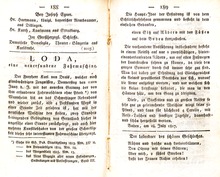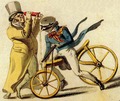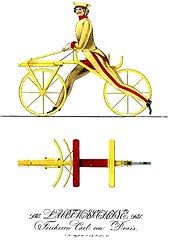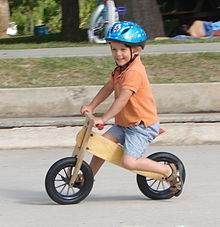Draisine (walking machine)
The draisine or walking machine (also the name used by the inventor) is a single-track, human-powered vehicle without pedals , which is considered the archetype of today's bicycle . It was introduced by the Baden inventor Karl von Drais in 1817 and a patent was applied for in 1818 (Baden privilege from January 12, 1818 and French certification from February 17, 1818). Alleged predecessors from the 18th century were actually a French priority fairy tale from 1791. The walking machine allegedly built by Michael Caßler in 1761 is in the Deutsches Museum and can probably be assigned to Mechanikus Hoffmann in Leipzig in 1817.
History & technology
Drais' carriage without horses (1813)
Drais had already applied for a patent on October 27, 1813 for a four-wheeled “horse -free carriage” that was moved by means of a crankshaft and demonstrated such a vehicle in Karlsruhe at the beginning of December 1813 on the occasion of a visit by Tsar Alexander I to Margravine Amalie von Hessen-Darmstadt . The tsar is said to have exclaimed "C'est bien ingénieux" and presented Drais with a diamond ring. Johann Gottfried Tulla and Friedrich Weinbrenner were commissioned by Grand Duke Karl Ludwig to draw up a report on the usefulness of the machine, which they could not recognize in their letter of December 17, 1813. The demonstration of the four-wheeled vehicle at the Congress of Vienna was also unsuccessful for Drais.
Drais' single-track walking machine (1817)

Karl von Drais developed a single-track version by the summer of 1817 and took the first long journey on June 12, 1817 from his home in Mannheim on the well-developed “ Chaussee ” to the Schwetzinger Relaishaus in what is now the Mannheim district of Rheinau with the machine built by the Mannheim wheelwright Frey . "It took him one hour to travel four hours by post." “Thirteen to fifteen kilometers per hour without great effort, that was a sensation”. The trolley made it possible to move quickly on level terrain.
Public performance in the Jardin du Luxembourg (April 5, 1818)
Austrian variant from 1818 ( Franz Schubert and Leopold Kupelwieser ; steering incorrectly shown)
technology
A saddle as a seat and a padded board (“balancing board”) to support the forearms are attached between two wagon wheels standing one behind the other. Behind the "padded riding seat there is a small board to fasten a travel bag with a strap."
The hands are on the handlebars of the front wheel. The vehicle is moved by alternately pushing the feet on the ground. Iron protective caps were screwed onto the tips of the shoes. The rear wheel is firmly mounted in the frame, while the front wheel is rotatable in its axis as a whole around a vertical threaded bolt. This is the principle of turntable steering already known from carriages . The steering axis was about 15 cm in front of the front wheel axis. The rear wheel could be braked with a drag brake . Drais' original version made of ash wood weighed less than 50 pounds, not much more than today's Dutch bike , but had more caster thanks to the steering axle .
Drais advertised his walking machine with a brochure with the following properties:
"1. The machine goes uphill, on good country roads, as fast as a person with a strong step.
2. On the plain, even immediately after a heavy thunderstorm, like the staff of the sentries, in an hour 2 [post hours walk]
3. On the plain, with dry footpaths, like a horse galloping, in an hour around 4 [post hours Path]
4. Downhill, faster than a horse in Carrière [racecourse]. "
Patents & Sales (from 1818)
Drais sold the draisine for 1 Carolin (44 guilders ) - a machine with adjustment options for different body sizes was available for 50 guilders - with a small metal plate with his coat of arms. The owner thus acquired the right to drive the machine in accordance with the Baden privilege of January 12, 1818. Drais delivered machines to the Duke of Saxe-Weimar , Duke of Gotha , Count von Lindemann in Frankfurt an der Oder, General von Pelet , Count Strascensky in Prague and Chamberlain Reuttner von Weyl in Aichstetten . Its copy was given to the Germanisches Nationalmuseum in Nuremberg by his grandson in 1884 ; today this original is on permanent loan in the Deutsches Museum in Munich.
The French patent was given to Karl Drais (No. 896, "vélocipède") on February 17, 1818, the English patent to Denis Johnson (No. 4321, "Pedestrian Curricle" or "Dandy Horse") and the American one on December 22, 1818 WK Clarkson patent on June 26, 1819. The running machine was named "Draisine" in the newspapers after its inventor, and "Hobby Horse" in the Anglican-speaking area. In England in 1819 Birch manufactured ladies' draisines with low access and a machine for country mail carriers, and Lewis Gompertz in 1821 a draisine that was moved with a hand crank with a gear segment.
Invention forgotten (after 1822)
On January 5, 1822, Drais traveled to Brazil with Georg Heinrich von Langsdorff as a surveyor on his Facenda and stayed in Brazil until June 1827. In the meantime, his walking machine was forgotten. In 1833, Drais mentions that a certain Döring in Karlsruhe was building walking machines for children. Drais himself improved his machine several times and drove it until his death. The estate machine is now in the Prinz-Max-Palais in Karlsruhe.
Further development to the bicycle (from 1861)
In 1861, the draisine reappeared in a purposefully modified design. The French Pierre Michaux and Pierre Lallement (US patent 1866) had cranks on the front wheel. Furthermore, the frame was now made of forgeable cast iron and the saddle was spring-loaded. At the world exhibition in Paris in 1867 , Michaux's production, financed by the Olivier brothers, became world famous. The Oliviers brought disputes to an end in court and founded their factory for the production of bicycles, the Compagnie Parisienne, ancienne maison Michaux & Comp . The vehicles were called Vélocipède bicycle . Several years passed before John Boyd Dunlop reinvented pneumatic tires and developed the bicycle chain .
Utopia motorcycle: Vélocipèdraisiavaporianna
As early as 1818, an unknown French artist developed the utopia of the steam-powered Vélocipèdraisiavaporianna , which combined the steam engine with the newly released draisine. This fantasy was 50 years ahead of technical reality: the development of the steam bike and forerunner of the motorcycle .
Historical context of development
According to different theories, external circumstances led to the invention of the walking machine, as well as to its prohibition or preventing its success.
- Tambora hypothesis
After a 1996 developed thesis of Hans-Erhard Lessing the development of the impeller was affected by famine , lack of food ( oats ) and horses dying after Tambora - eruption in 1815, one of the largest natural disasters of history, on the northern hemisphere in the summer of 1816 by cold and steady rain led to crop failures ( year without summer ) and caused grain prices to rise.
Drais wrote in 1813 on the occasion of his desired patenting of a four-wheeled cart: "In times of war, when horses and their feed are often rare, such a cart could be important" - muscle power instead of a draft horse . A bad privilege had been refused, and Drais turned to other inventions. Lessing sees the connection between the famine prevailing at the time , the death of horses due to lack of feed and the two-wheeler invention by Drais as conclusive.
The thesis was challenged in 2017 by Jost Pietsch, who objected to incorrect sources and pointed out that the draisine was then only considered a curiosity and could in no way serve as a horse replacement. The connection, assumed by Lessing, between the Tambora eruption and the Drais invention is not considered proven today.
- boycott
“These walking machines were only successful for a few years, the authorities soon forbade driving on the sidewalks, and after Sand's execution in 1820, the fraternity members mobbed the inventor and son of the court judge. The invention was somewhat forgotten. Since people were afraid of balancing, they preferred to resort to multi-lane velocipede […]. About 50 years later, roller skating rinks appeared, and the population was more willing to dare to balance. Now the bicycle was called "vélocipède bicycle" , so "two-wheeled fast foot " . "
- Driving bans
“Due to worldwide driving bans, this means of transport, which could be used to walk around three times the speed, did not gain sustained use in the first half of the 19th century. The preference of the handcar drivers for comfortable surface surfaces soon led to conflicts in times when the lanes on city streets were furrowed and dirty and only the sidewalks were flat and clean. Driving on the sidewalks was banned in Mannheim as early as December 1817, in Milan in 1818, in London, New York and even Calcutta in 1819. "
Children's balance bike
Even in Drais' time there were children's walking machines, later known as celerettes. The first children's tricycles appeared in 1860. In the 20th century new arisen children impellers ( English balance bicycle ) for about two to six years; these quickly became popular. According to Marc Brost and Wolfgang Uchatius, the product designer Rolf Mertens reworked these devices, which are well-designed for learning to walk and balance. The first of these children's exercise bikes were made of wood, now those with tubular frames made of steel or aluminum are widespread, frames made of glass fiber reinforced plastic (injection molding) are more rarely offered. Small rims in particular are often made of plastic. There are wooden disc wheels with hard rubber tires, but mostly with pneumatic tires in aluminum rims. Spoked wheels have a certain risk of pinching, the wheel flanks are rarely partially covered by standing, bulged protective discs. Tires made of PU foam are a little heavier, have more rolling resistance, but are vandalism-proof and more reliable than pneumatic tires, as they cannot leak, do not need a valve and do not have to be re-pumped. Newer models are equipped with hand brakes, a front brake is not recommended by the German Road Safety Council due to the risk of falling.
Balance bikes are - as a preliminary stage to scooters - suitable for children from the age of around two to two and a half years and are usually used up to and including five years.
literature
- Carl Johann Siegmund Bauer: Description of the v. Drais'schen driving machine and some attempts to improve it. Nuremberg 1817. Reprint: Westhafen Verlag, Frankfurt am Main 2016, ISBN 978-3-942836-09-8 .
- Hermann Ebeling: The Baron von Drais: the tragic life of "the crazy baron"; an inventor's fate in the Biedermeier period. Braun, Karlsruhe 1985, ISBN 3-7650-8045-4 .
- Franz Maria Feldhaus : The technology. A lexicon of prehistoric times, historical times and primitive peoples. Engelmann, Leipzig and Berlin 1914.
- Hans-Erhard Lessing : Automobility - Karl Drais and the incredible beginnings. Maxime, Leipzig 2003, ISBN 3-931965-22-8 .
- Hans-Erhard Lessing : How Karl Drais invented the bicycle - a little history of the running machine. Lauinger, Karlsruhe 2017, ISBN 978-3-7650-8431-7
- Max JB Rauck, Gerd Volke, Felix R. Paturi: By bike through two centuries. The bicycle and its history. 2nd Edition. AT Verlag, Aarau et al. 1979, ISBN 3-85502-038-8 .
- Michael Rauck: Karl Freiherr Drais von Sauerbronn , contributions to economic and social history 24. Steiner-Verlag, Stuttgart 1983
Web links
- Marchivum , research The first bike tour in the world - Baron von Drais' running machine
- History of the bicycle
- January 12, 1818: Patent for the draisine
Remarks
-
↑ Die Zeit : Climate Change: Everyone was talking about the weather (April 5, 2015) (moves the invention of the walking machine to Karlsruhe)
Matthias Schulz: Planet Asche . In: Der Spiegel . No. 15 , 2015, p. 116 f . ( online - April 4, 2015 ). FAZ : Volcanic Eruption, The Eruption That Made Europe Tremble (April 7, 2015) and Süddeutsche Zeitung : Summer Without Sun (April 10, 2015) What does the invention of the bicycle have to do with volcanoes? (No longer available online.) ARD , July 10, 2012, archived from the original on August 8, 2016 ; accessed on August 8, 2016 . accepted the thesis uncritically.
-
↑ Lessing ( What led to the Invention of the early Bicycle? In: Cycle History. No. 11 (2000), Van der Plas, San Francisco 2001.) sees a “highly probable” boycott in the “silence of the newspapers about the draisines” towards the son of the court judge; He definitely sees a connection with Drais' exile in Brazil (1822 to 1827) for more than five years.
Ice skates and running with them corresponded to balancing much earlier. - ↑ The catastrophic road conditions were one of the reasons that the attempts in Drais' time were hopelessly doomed to failure. Paved roads were essentially only in larger towns, country roads were rarely paved and when they were, with rough cobblestones. See Max JB Rauck, p. 13.
- ↑ In 1822 there was a police ordinance in Mannheim that prohibited the use of the palace gardens with running bikes. See Ebeling, p. 87. A prohibition prior to patenting has not been proven.
Individual evidence
- ↑ Hans-Erhard Lessing: How Karl Drais invented the bicycle, Lauinger Karlsruhe 2018, Appendix D.
- ^ Hermann Ebeling: The Baron von Drais. P. 53 ff.
- ↑ Badwochenblatt for the Grand Ducal City of Baden, issue No. 24 of July 29, 1817, p. 188.
- ^ Hermann Ebeling: The Baron von Drais. P. 67.
- ↑ Max JB Rauck, p. 21.
- ↑ Carl Johann Siegmund Bauer, p. 23.
- ↑ 1 pound = 467.290 g.
- ^ Hermann Ebeling: The Baron von Drais. P. 71.
- ↑ Draissine according to Brockhaus, supplement volume 1819, p. 379.
- ↑ Anton Daul: Illustrated history of the invention of the bicycle and the development of motorcycles. Verlag Creutz, Dresden, 1906., p. VIII.
- ↑ Coat of arms of the Drais von Sauerbronn family. Nine red stones in the shape of a St. Andrew's cross
- ↑ a b Feldhaus, p. 237.
- ^ Hermann Ebeling: The Baron von Drais. P. 69.
- ↑ Feldhaus, Appendix I, pp. 11-13.
- ^ Hermann Ebeling: The Baron von Drais. Pp. 95, 101.
- ↑ Drais' walking machine, original
- ↑ Hans-Erhard Lessing: Karl von Drais - The Empire Technologist is rehabilitated. In: Mannheim history sheets. NF 3 (1996), pp. 275-359.
- ↑ Tambora and the "Year Without a Summer" 1816 on unibe.ch (accessed April 27, 2017)
- ^ Drais memorial by Sven Fink
- ^ Hans-Erhard Lessing: Automobility. Pp. 120-121.
- ^ Hans-Erhard Lessing: What led to the Invention of the early Bicycle? In: Cycle History. No. 11 (2000), Van der Plas, San Francisco 2001.
- ↑ Jost Pietsch, The great Tambora swindle
- ^ A b Christian Wüst: veil over it . In: Der Spiegel . No. 10 , 2017, p. 98 ( Online - Mar. 4, 2017 ).
- ↑ Holger Sonnabend , Gerrit Jasper Schenk: Initiatives for historical disaster research (2006)
- ↑ Pryor Dodge: The fascination of bicycles. History - technology - development . Translated from the English by Renate Bauer-Lessing. Moby-Dick-Verlag, Kiel 1997, ISBN 3-89595-118-8 (Delius-Klasing)
- ↑ Cf. Lessing in Carl Johann Siegmund Bauer: Description of the v. Drais' driving machine. , P. 94.
- ↑ Rauck, p. 156.
- ↑ A wheel for Germany . In: The time . No. 17, April 16, 2009, p. 19
- ↑ DVR Moderators Manual, 2nd edition 2009, p. 65.
















